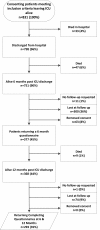An exploration of social and economic outcome and associated health-related quality of life after critical illness in general intensive care unit survivors: a 12-month follow-up study
- PMID: 23714692
- PMCID: PMC3706775
- DOI: 10.1186/cc12745
An exploration of social and economic outcome and associated health-related quality of life after critical illness in general intensive care unit survivors: a 12-month follow-up study
Abstract
Introduction: The socio-economic impact of critical illnesses on patients and their families in Europe has yet to be determined. The aim of this exploratory study was to estimate changes in family circumstances, social and economic stability, care requirements and access to health services for patients during their first 12 months after ICU discharge.
Methods: Multi-center questionnaire-based study of survivors of critical illness at 6 and 12 months after ICU discharge.
Results: Data for 293 consenting patients who spent greater than 48 hours in one of 22 UK ICUs were obtained at 6 and 12 months post-ICU discharge. There was little evidence of a change in accommodation or relationship status between pre-admission and 12 months following discharge from an ICU. A negative impact on family income was reported by 33% of all patients at 6 months and 28% at 12 months. There was nearly a 50% reduction in the number of patients who reported employment as their sole source of income at 12 months (19% to 11%) compared with pre-admission. One quarter of patients reported themselves in need of care assistance at 6 months and 22% at 12 months. The majority of care was provided by family members (80% and 78%, respectively), for half of whom there was a negative impact on employment. Amongst all patients receiving care, 26% reported requiring greater than 50 hours a week. Following discharge, 79% of patients reported attending their primary care physician and 44% had seen a community nurse. Mobility problems nearly doubled between pre-admission and 6 months (32% to 64%). Furthermore, 73% reported moderate or severe pain at 12 months and 44% remained significantly anxious or depressed.
Conclusions: Survivors of critical illness in the UK face a negative impact on employment and commonly have a care requirement after discharge from hospital. This has a corresponding negative impact on family income. The majority of the care required is provided by family members. This effect was apparent by 6 months and had not materially improved by 12 months. This exploratory study has identified the potential for a significant socio-economic burden following critical illness.
Figures





References
Publication types
MeSH terms
Grants and funding
LinkOut - more resources
Full Text Sources
Other Literature Sources
Medical

